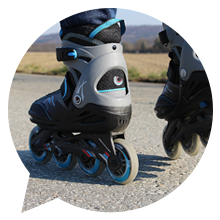Heelys

Heelys were a very popular Christmas present and are the must-have accessory of the moment. The craze for Heelys is a good opportunity for children to obtain some form of exercise in a time of rising concern over child obesity. Instead of sitting down in front of the TV or PlayStation, Heelys provide a fun, exciting, and exceptionally 'cool' way for children to get out in the fresh air and obtain some kind of healthy exercise.
With such a dramatic rise in use there is bound to be a notable increase in incidents and accidents to users, similar to when micro-scooters were introduced a few years ago, and when there have been similar crazes for skateboards and inline skates. Play often leads to children being hurt – it is part of growing up. There are bound to be the odd bumps and bruises. The following information sheet looks at how wearing the right safety gear and considering the places best suited to skating can reduce the risk of serious injury while enjoying heeling.
Safety issues
- Injuries sustained by users of Heelys are similar to those of roller skating but heelers are less likely to wear the same safety gear.
- Those not wearing safety gear represent a majority of victims and research shows that many children do not have the safety gear to wear.
- The most significant Heely-induced injuries are those to the upper-limb, and the most common way of becoming injured is by slipping backwards while on level ground.
- A high number of accidents occur to new heelers, and injuries to wrists typically occur in the first few days of learning to use Heelys.
- As proficiency and confidence grows, and the heeler starts performing more courageous movements, the type of injury changes to those caused by collisions.
- A number of incidents of victims of accidents involving Heelys have been reported in the UK and Northern Ireland, and they have been blamed on an increase in child admissions into A & E.
- Similar to skateboarding, the most serious injuries occur when there is interaction with the road.
- In 2002 there were an estimated 20,000 roller skating, inline skating and blade accidents where the victim attended hospital in the UK.
Safety equipment
Studies show that the typical injuries that occur to wrists, arms and elbows are to casualties who were not wearing any protection and could possibly have been avoided if they had been. Before using Heelys think about putting on some safety gear to reduce the risk of serious injury:
- Wrist guards and helmets are particularly important in limiting injuries to those starting out.
- Once users reach a level where they are attempting tricks, advanced manoeuvres and travelling faster they should consider wearing safety equipment such as helmets (meeting BS EN1078), knee pads, elbow pads, and wrist protectors (BS EN14120) as skateboarders and inline skaters do.
- If you are buying Heelys for a child who has not used them before consider a two-wheeled model as it provides better stability and balance.
The best places to skate
- Skate in areas that are smooth and not too steep, without stones, rocks, cracks or steps and try to avoid sand, mud and water.
- Think about how to avoid collisions with pedestrians, street furniture etc.
- Avoid areas where there is the possibility of accidentally skating into the path of vehicles.
- Consider others – be aware of where you could hurt other people, and that some shops and shopping centres have stopped the use of Heelys in their premises.
- Skating indoors (e.g. in a house or supermarket) increases the risk of hitting hard objects when falling causing a more serious type of injury.
Top tips for starting out
- Get some safety gear before you start out.
- Ensure the wheels are securely locked into the heel bracket.
- Find your balance on the wheels while near to an object or person you can rely on to give you support.
- Practice heeling with your most comfortable leg in front of the other while holding onto something stable – don't heel with your feet side by side.
- If using your Heely shoes only for walking, remove the wheels.
- Only skate within your normal walking or running speed.
- To regain your balance put your toes back down and walk or run out of the motion.
Notes
Heelys are a patented product. There are also various other similar products available for purchase and this information sheet can also be applied to them generally, as shoes with wheels in the heels.
Data taken from the Home and Leisure Accident Surveillance System (HASS/LASS) Database. This is sample data taken from a sample of 16-18 UK hospitals. It does not include fatalities. The latest data available is for 2002.
Further information